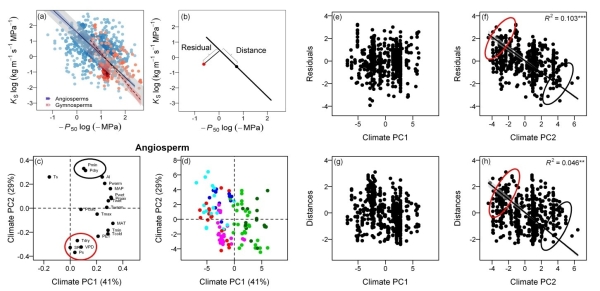

A classic theory proposes that plant xylem cannot be both highly efficient in water transport and resistant to embolism, and therefore a hydraulic efficiency-safety trade-off should exist. However, the tradeoff is weak and many species exhibit both low efficiency and low safety, falling outside of the expected tradeoff space. It remains unclear under what climatic conditions these species could maintain competitive fitness.
To explore reasons for this weak hydraulic trade-off pattern, researchers from South China Botanical Garden of Chinese Academy of Sciences compiled hydraulic efficiency and safety traits for 682 observations of 499 woody species from 178 sites worldwide, and measured the position of each observation within the proposed trade-off space. They found that for both angiosperms and gymnosperms, observations from sites with high climatic seasonality, especially precipitation seasonality, tended to have higher hydraulic safety and efficiency than observations from sites with low seasonality. Specifically, high vapour pressure deficit, high solar radiation, and low precipitation during the wet season were driving factors (Figure). Strong climatic seasonality and drought in both dry and wet seasons appear to be ecological filters that select for species with co-optimized safety and efficiency, whereas the opposite environmental conditions may allow the existence of plants with low efficiency and safety.
This study expanded previously proposed physiological explanations to large ecological scale, providing a new insight in understanding and predicting the departure from the trade-off under future climatic changes.
This work has been published online in New Phytologist, entitled “Weak tradeoff between xylem hydraulic efficiency and safety: climatic seasonality matters”. For further reading, please refer to: https://doi.org/10.1111/nph.16940.

Figure. Plant hydraulic trade-off is aligned with climate at the global scale. (a) hydraulic trade-off among angiosperms and gymnosperms; (b) Definition of Residual and Distance in trade-off space; (c-d) PCA on climatic variables to find the key factors in separating species from different biomes (different colors in d); (e-f) PC2 drives the trade-off Residual; (g-h) PC2 drives the trade-off Distance. Black and red circles in (c) correspond to their positions in (f) and (h). Black circles indicate dry season precipitation (Pmin, Pdry); red circles indicate high precipitation seasonality (Ps), vapor pressure deficit (VPD) and solar radiation (SR), together drive species to locate close to the upper-right corner in the hydraulic trade-off space in (b)

